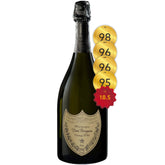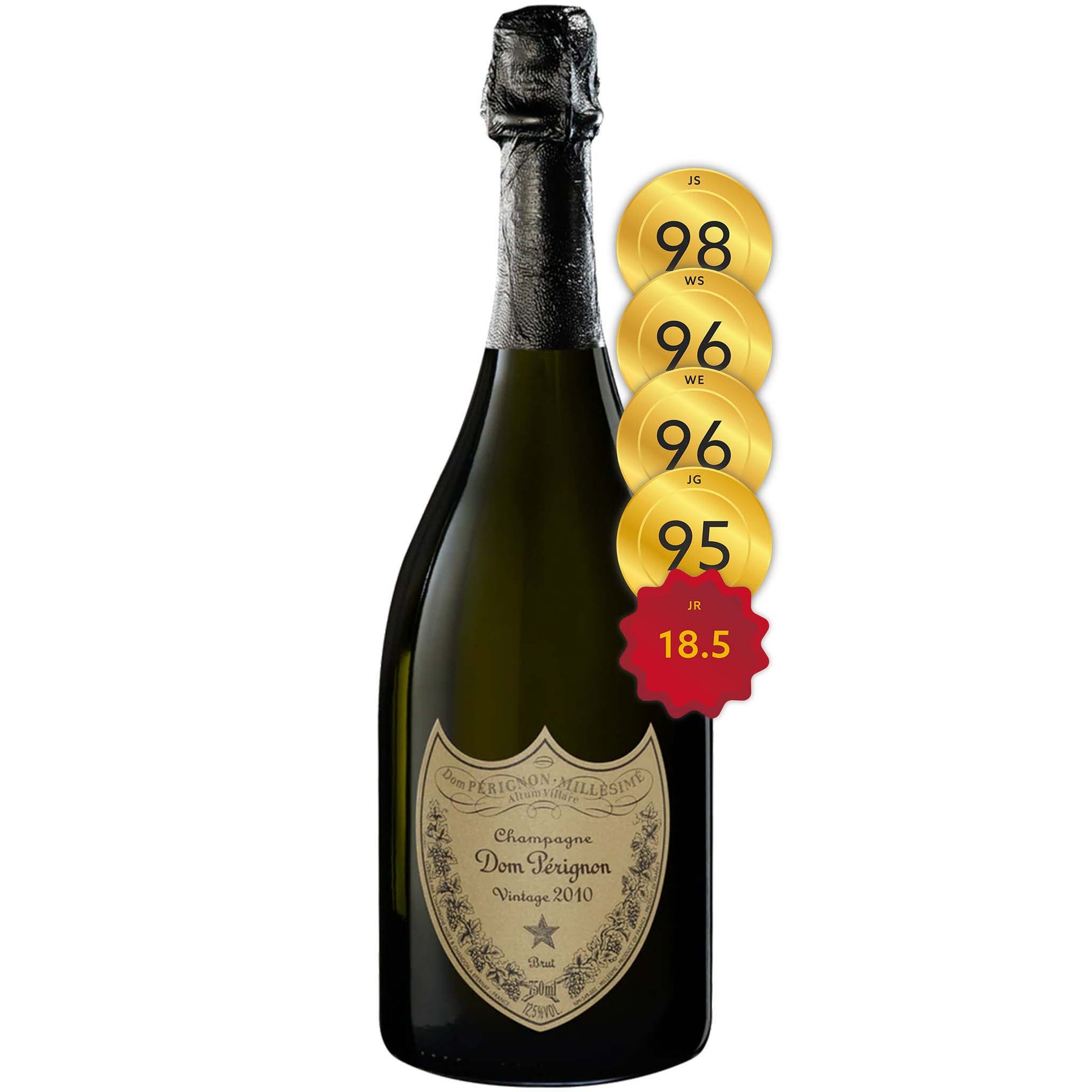
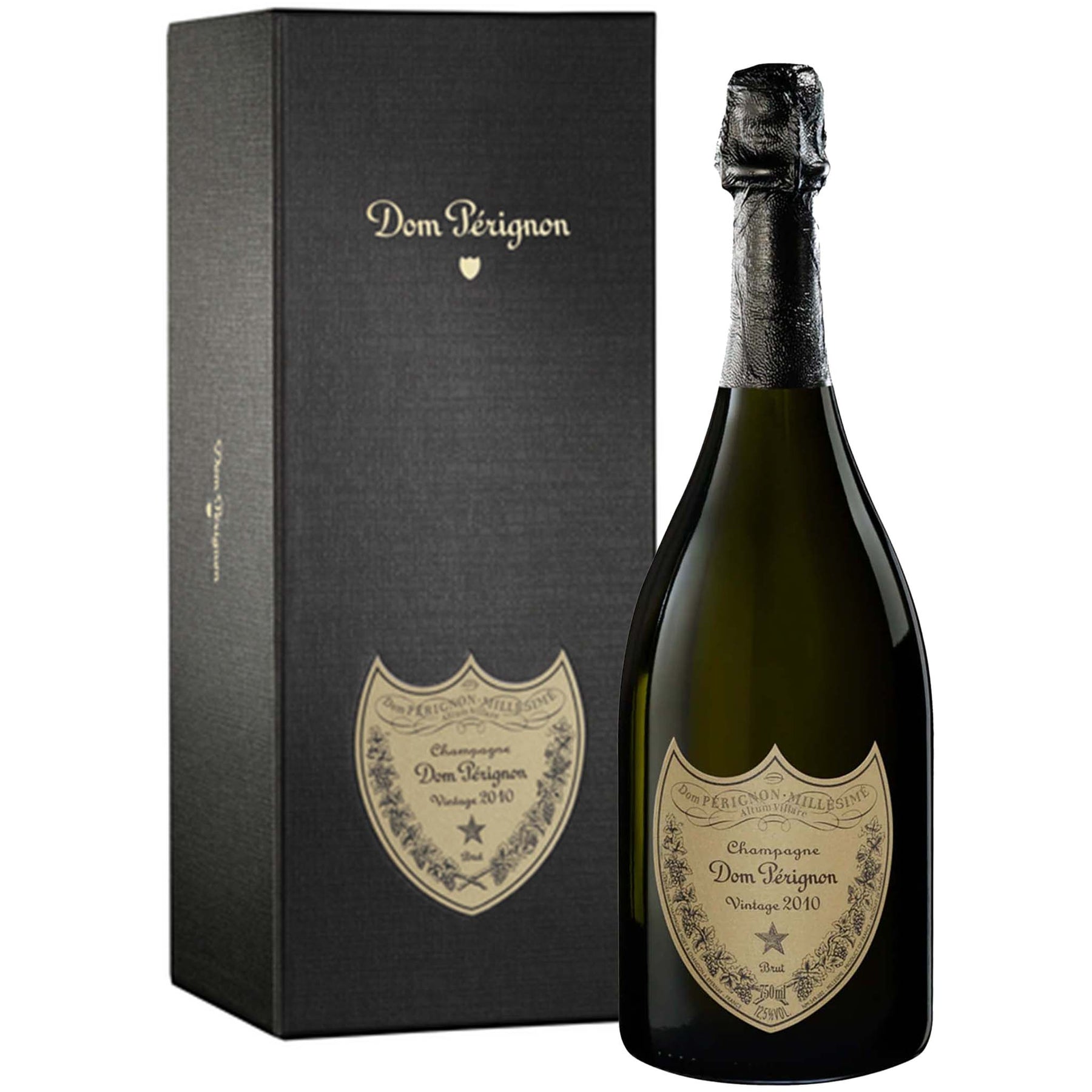
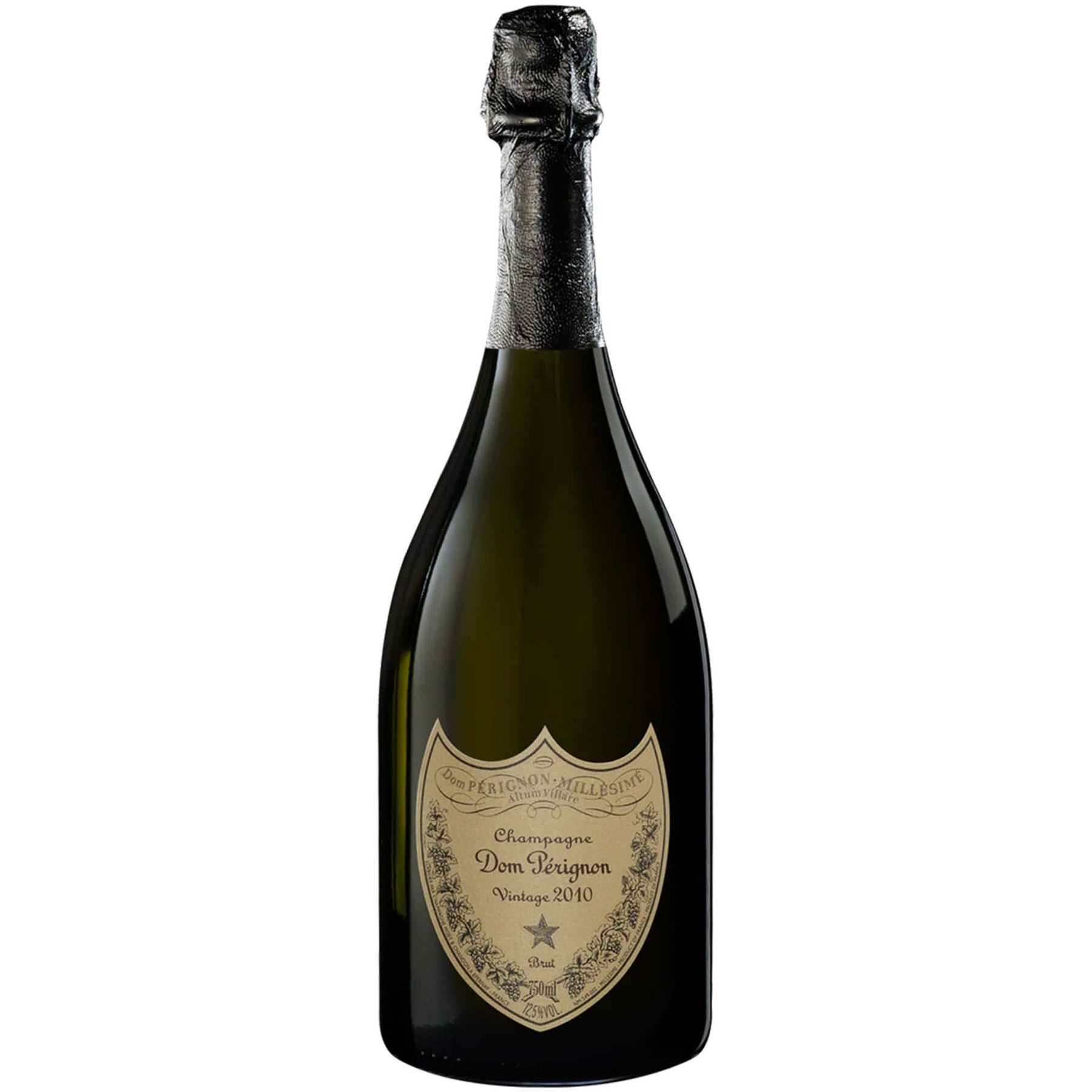
Dom Pérignon 2010
Style: Champagne Extra Brut
Varieties: Pinot Noir (50%), Chardonnay (50%) ≈
Closure: Cork
Dom Pérignon 2010
Warehouse
34 Redland Drive
Vermont VIC 3133
Australia
Critic Score: 98 and 18.5/20
Alcohol: 12.5% Dosage: 5g/l
Size: 750 ml
Drink by: 2050
"Krug is the king of champagne, Dom Perignon is the Queen." James Halliday
Dom Pérignon is named after a 17th century Benedictine monk who was Cellar Master at the Abbey of Hautvillers, near the town of Épernay. It is the top Champagne (prestige cuvée or tête de cuvée) produced by Moët & Chandon and was first released in 1937 with the 1921 vintage. Although owned by Moët & Chandon, Dom Pérignon is now considered a separate Champagne house. It is a vintage Champagne, a blend of approximately 50% Pinot Noir and 50% Chardonnay that showcases both the character of the year and the character of Dom Pérignon. Dom Pérignon is aged in the cellars of Moët & Chandon for at least 8 years in bottle on lees before release. It is only produced in years where growing conditions are favourable: it is down to the Chef de Cave to decide if the vintage will be declared.
"The 2010 vintage of Dom Pérignon is a beautiful wine. On the palate the wine is deep, full-bodied, focused and complex, with a fine core of fruit, excellent mineral drive, bright, bouncy acids and a very long, very complex and surprisingly wide open finish. This is the rare vintage of Dom Perignon that drinks well out of the blocks, and of all the recent vintage releases of this wine, the 2010 is unequivocally the one I would choose for drinking over the next decade!" John Gilman
"On the nose the luminous sweetness of tropical fruit – green mango, melon, pineapple – instantly shines. It then cedes to more temperate notes, the tingle of orange zest, the mist of a mandarin orange. The wine breathes, revealing its freshness. The bloom after the rain. A tactile sensation of peony, jasmine and lilac. The wine immediately imposes its ample presence, full and massive. A sappy sensation dominates as the tactile is rapidly overtaken by the aromatic. The body unfolds: generous, firm and controlled. Then it contracts, letting the wine vibrate with spices and pepper. The energy is sustained to a scintillating, saline finish.
2010. Winter was rigorous, spring dry and late. Summer was hot, but not excessively so. Then, two days of diluvian rain brought this ideal trajectory to a halt. In just a few days, botrytis mold developed on the grapes, mainly on the pinot noir. Dom Pérignon deployed its full resources to trace a precise map delimiting the maturity and health of each parcel in its vineyards. This expert vision of the situation gave the possibility of saving excellent plots of pinot noir grapes. Dom Pérignon declared a vintage quite literally "saved from the waters": Dom Pérignon Vintage 2010, fruit of intuition and mastery." Dom Pérignon
Expert reviews
"A firm and vivid Champagne with a precise, focused palate. Full-bodied and dry. It's very layered and bright with light pineapple, peach, praline, cooked-apple and stone aromas and flavors. It's very subtle and focused at the end. Integrated with richness and high acidity. Good depth. Reminds me of the 1995. Very clean. Solid. Lovely to drink already, but will age nicely." James Suckling - 98 points
"A graceful Champagne, featuring fragrant notes of toasted brioche and grilled nut that are more subtle on the palate, transitioning to a rich underpinning layered with a pure chime of tangerine and accents of candied ginger, toasted saffron and lime blossom. This bundles a lot of concentrated flavor into a lithe frame. The fine mousse caresses the palate through to the lasting finish. Drink now through 2035." Alison Napjus, Wine Spectator – 96 points
"Amazingly, obviously, Dom P on the nose – the powerful lemon-mousse nose came soaring out of the glass long before my nose got anywhere near it. Massive intensity of complex aroma hints that this might be a little blowsy on the palate but not a bit of it. It's really tense and tight and has a certain fumy smokiness to the very concentrated palate. But its most marked feature is the persistence of the finish. This, along with the concentration, makes me confident we will be seeing this in a P2 version, even though 15% of the potential Pinot Noir was left on the ground. Definitely not a weak vintage of Dom P." Jancis Robinson MW – 18.5/20 points
"The new release of this iconic Champagne shows its richness to perfection. The floral aromas lead to a wine that has weight and density as well as a balance that encompasses ripe fruits that have now matured to reveal nuttiness, toast and a tight salinity at the end. Drink through 2028." Wine Enthusiast – 96 points
"The 2010 vintage of Dom Pérignon is a beautiful wine, and rather uncharacteristically for this long-distance runner of a Tête de Cuvée, the wine is quite flattering to drink out of the blocks, as its customary steely structure is more giving than usual at such a young age. The bouquet wafts from the glass in a very refined blend of apple, lime, menthol, chalky minerality, gentle smokiness, a delightful touch of DP’s signature botanicals and a topnote of citrus peel. On the palate the wine is deep, full-bodied, focused and complex, with a fine core of fruit, excellent mineral drive, bright, bouncy acids and a very long, very complex and surprisingly wide open finish. This is the rare vintage of Dom Perignon that drinks well out of the blocks, and of all the recent vintage releases of this wine, the 2010 is unequivocally the one I would choose for drinking over the next decade! That said, it is also very well-balanced and may well surprise us with how well it ages!" John Gilman - 95 points
Dom P1, P2, P3

Dom Pérignon
Dom Pérignon is the top Champagne (prestige cuvée or tête de cuvée) produced by Moët & Chandon and was first released in 1937 with the 1921 vintage. It is a vintage Champagne made from Pinot Noir and Chardonnay. Each year, the Chef de Cave reinvents the House style, creating a unique wine that is a perfect balance between the expression of Dom Pérignon and the expression of the vintage itself.
Dom Pérignon is a blend of approximately 50% Pinot Noir and 50% Chardonnay. The grapes are sourced from many Grand Cru vineyards, the very best vineyards in Champagne. In addition, each blend always includes grapes from the original plot in the Abbey of Hautvillers, a Premier Cru vineyard.
The wine owes its complexity to the slow ripening of the grapes, which conserves freshness while revealing new aromas and new textures with the passing of time. These aromas, which develop in the wines as they are protected from oxygen during the aging process, guarantee exceptional cellaring potential and a characteristic minerality which is an aromatic signature of the House.
The three Plénitudes
Every Dom Pérignon goes through three different stages of development or Plénitudes as it is aged in the cellars of Moët & Chandon. Champagne undergoes a secondary fermentation inside the bottle - this is what creates the fizz that once had Dom Pierre Pérignon enthusiastically exclaim "Come, I am drinking stars!" when he first tasted the sparkling wine that is now known as Dom Pérignon. The yeast performing this secondary fermentation turns into lees that remain in the bottle until it is disgorged. Then and only then is it fit to be tasted by Champagne lovers, and to be stored like any other bottle of fine wine for future enjoyment. However, what happens when a bottle is not disgorged? The lees participate in a mysterious evolution of the wine in the bottle, singular to each cuvée and carefully monitored by the Chef de Cave.
Dom Pérignon has truly mastered the art of prolonged lees ageing. Dom Pérignon is blended with a 40 years’ time perspective in mind and maturation on lees is part of the blend. Every vintage must have the capacity to shine as Plénitude 2 and Plénitude 3, otherwise it will not declared. Each P2 and P3 is disgorged three years before being brought onto the market.
"Each vintage of Dom Pérignon is disgorged and (re)released only when I consider it has reached a new Plénitude, a privileged period of time when Dom Pérignon attains its radiance. Its development comes in successive plateaux which define as many windows of expression I decided to call Plénitudes: the wine then tells us a story that is new and exciting enough to be worth sharing.
Many Dom Pérignon lovers like to compare the trajectories of a bottle of Dom Pérignon Vintage, stored at their place, side by side with a bottle of Dom Pérignon P2 or P3 that has been stored on its lees in our cellars in Epernay. The three Plénitudes side by side is the ultimate horizontal tasting of one and only vintage. Each wine - each Plénitude - will reveal a different facet of Dom Pérignon: P2 and P3, thanks to the extra time spent maturating on their lees under our careful attention, will grant you an experience ever closer to the Spirit of Dom Pérignon." Chef de Cave, Richard Geoffroy

The three Plénitudes of Dom Pérignon: P1, P2 & P3 (from left to right)
First Plénitude (P1) or Dom Pérignon Vintage
The wine is aged in the cellars of Moët & Chandon for at least 8 years in bottle on lees before it reaches its first stage of development or Plénitude (P1). The first Plénitude shows promise, completeness and harmony. Everything is in place. The Chef de Cave assesses the quality of the wine and decides if the vintage will be declared. If the vintage is declared, the wine is disgorged and released and is called Dom Pérignon Vintage.
Second Plénitude (P2) or Dom Pérignon P2
The second stage of maturity or second Plenitude (P2), which was formerly called Oenotheque, is reached after at least 15 years of ageing in the cellars. It is more intense, precise and vibrant, energized by the transformation. A true metamorphosis: its universe has expanded. If the quality of the wine reaches the desired standard, it is disgorged and released as Dom Pérignon P2.
The following text is taken from an interview with Chef de Cave, Vincent Chaperon, by Berry Bros & Rudd (bbr.com)
What was the rationale behind launching Plénitude 2?
The idea behind Plénitude 2 has always been to share more about Dom Pérignon with our consumers. Quite simply, Plénitude 2 shares the arc of a wine’s life – its history. And that history does not stop at the vintage; our wines continue to become more intense, complex and streamlined with longer maturation.
What happens in the bottle during this additional ageing time?
With this extra time, the inner activity in the bottle increases. The yeast transfers its energy to the wine – a mysterious transfer of life. After close to 15 years, expansion of energy reaches its peak, and Dom Pérignon rises to an apex of essential, radiant vitality in its state of Plénitude. Elevated to new heights, it unfurls across every dimension – wider, deeper, longer, more intense – and is gifted further with an extended longevity.
How do you determine when Plénitude 2 is ready for release?
It’s never predetermined. We closely follow the evolution of each of our vintages during their maturation in the cellars. Every six months or so, we open several bottles of each vintage. As soon as we feel that the wine is entering its peak of energy and reaching its Plénitude 2, we prepare for its release. It’s the wine that decides.
How does Plénitude 2 stand alongside other wines in the Dom Pérignon portfolio?
I tend to say that Plénitude 2 is "more" Dom Pérignon, because the additional maturation time further enhances Dom Pérignon’s singularity. It’s Dom Pérignon "higher and further". Even if Dom Pérignon is "one and indivisible", Plénitude 2 carries for the whole the art of addressing time. Time is in the equation of Dom Pérignon, and Plénitude 2 tells us that maturation is a time of construction, a time of growth and expansion for the wine.
Third Plénitude (P3) or Dom Pérignon P3
Finally, the third stage of development or Plénitude (P3) is reached after a period of at least twenty-five years of aging in the cellars. At this venerable age, all the components are completely integrated and the wine has become more streamlined and complex than ever. If the third Plénitude reveals the heritage of Dom Pérignon, a living memory passed down through the generations of Chef de Cave, the wine is disgorged and released as Dom Pérignon P3.
Chef de cave

Richard Geoffroy, Chef de Cave 1990-2018
For 28 years, from 1990 to the end of 2018, Richard Geoffroy was Dom Pérignon’s Chef de Cave. In that time as the creative guide of the Maison, he declared 15 vintages, the last being the majestic 2008 vintage. During that time he demonstrated an unwavering commitment to pursuing Dom Pérignon’s aesthetic ideal and vision. He believed that to experience Dom Pérignon fully, to understand it, one also needed to experience all the vintages that were made but not declared - which meant, effectively, that only he could understand it.
At the end of 2018, Richard Geoffroy passed the torch to his successor, Vincent Chaperon. Vincent had worked alongside Richard Geoffroy since he joined Dom Pérignon in 2005.
When asked what he had learned from working alongside his protégé for 13 years, Richard Geoffroy replied: "It’s very clear - his energy. Looking back, it’s very much the same energy I had when I came to Dom Pérignon in 1990. He’s given me a renewed energy. I’ve given him love, I’ve given him my energy, and he gives me that back. He’s allowed me to continue to grow, and to not become an old asshole. It’s the truth. It is important to recognize the risk of becoming an old asshole. That’s the worst! And the best way to do that is to learn from others. If you rest in your personal comfort zone, you’re dead. It’s the relationships you have in your inner circle that count the most. Vincent has considerable humanity, and to me that’s much more important than having technical skills. And that’s what the maison needs. We have incredible technicians. More than ever, with great and varied experience and expertise. But what we need is to be human, to not get cold or arrogant. We need to be warm, and that takes awareness and a lot of energy."
The following text is taken from an article by Essi Avellan MW published in 2015 in Flacons of Champagne magazine
Chef de Cave Richard Geoffroy is not playing it safe with Dom Pérignon. There is a formidable legacy to guard for the region's first prestige cuvée that carries the name of Champagne's most mythical figure. But instead of securing it, it is reinvention and pushing the boundaries that recur in Richard Geoffroy's deeds. He is obsessed with progression.
'If you are a defender, you are already a loser. To me the major pitfall of champagne is repetition, which is often done in the name of consistency', he states as we sit across each other at the ascetic and airy second floor tasting room at the abbey of Hautvillers, the ancient home of the monk Dom Pérignon. Exchanging over a flight of Dom Pérignons, I am rewarded with fireworks of his insightful and opinionated say.
'Dom Pérignon's greatest asset is vision', Richard Geoffroy decides. It is easy to agree with that, as vision is exactly what Geoffroy has demonstrated during his 25 years at the head of the house. Dom Pérignon has been a major driver of champagne, whose prestige and global presence benefit the entire region. Under Geoffroy's wing the Dom Pérignon brand has been separated from Moët & Chandon and its image has gradually been rejuvenated from classic to contemporary, even avant-garde.
The last 10 years have seen a notably more communicative Dom Pérignon. I remark to Geoffroy that the Dom Pérignon brand has become friendlier. And the same goes even with the wine with its increasingly welcoming, polished, and seamless character. Was this visioned? 'Dom Pérignon is all about pleasure and joy, emotions. I want it to embrace you', Geoffroy agrees. The multitude of research and development carried out at Moët & Chandon has benefited Dom Pérignon quality, too. A friend of a less technical way of talking about wine, Richard Geoffroy often sounds more like a poet than a winemaker: 'We pay a lot of attention to the texture and flow of the wine. I like to call it the Dom Pérignon glide, reminiscent of the surfer riding the perfect wave'.
Driven, is the word that epitomises Richard Geoffroy, the man whose greatest fear in life is to dry out or wither. Thus he declares to enjoy the excitement of discovery and loves surprises. 'That is something I also want to include in a bottle of Dom Pérignon', he adds. Richard Geoffroy's boldness in making Dom Pérignon has resulted in increasing number of vintages produced, including the record-breaking five vintages in a row from 2002 to 2006. He is not shy to demonstrate a broader scope of vintage expressions: 'I feel I might be taking more risks than my predecessors did. For instance, there is no 1989 whereas I made 2003'. He seemingly thrives on challenges and is most proud of the wines of the demanding vintages: 'Out of all vintages I have made, I take the greatest pride in our 2003 wines, which was an unforeseen vintage characterised by extreme heat.'
There is also an element of surprise in his career path, as even if he comes from a family of vine-growers in Champagne, winemaking was not his first choice. 'I love designing, building and creating things. I could've been an architect. At the end I chose medicine and passed my doctorate in 1982', He remembers. However, soon after his studies, Geoffroy felt a strong attraction back to his roots, to winemaking: 'I was already 31 when I went to study oenology in Reims.' Since then Richard Geoffroy's path has been highly successful and advancement rapid at LVMH. As a lot of creating and construction takes place when crafting champagne of this quality and quantity level, no doubt he is also drawing to his work from his other life interests: 'Dom Pérignon is the most blended vintage champagne. The more wines we combine, the more robust, detailed and precise the wine can be. Champagne making is an options game, and I love options', he confirms.
In addition to being able to work with the outstanding raw material and great technological resources, Richard Geoffroy has the most glamorous job in Champagne. He travels extensively to share Dom Pérignon with the jet set of the wine and gastronomic world as well as celebrities one can only dream to meet. In a world like his it would be easy to lose track of ordinary life. In his shoes many would have built an attitude of arrogance, but Geoffroy's feet stay firmly on the ground. 'I am privileged to get to meet so many exciting people. Dialogue and sharing are the greatest gifts. If my work would be just technical, I would be long gone.' Even if he still greatly enjoys his adventures abroad, the recent years have made him more concerned and proud of his roots: 'I have done the full circle. Best place in the world is home and I enjoy most spending time with my own people; family, friends and colleagues.'
Geoffroy has an unusually reflective and mature perspective on life. Highly respected by his colleagues, he is known as a great mentor who will give opportunities to develop. 'I think knowledge and skill are best given forward. If you share them with others, the whole project will grow. I am not on an ego trip. I really believe generosity pays off, and that's what wine is all about', he reasons.
If, as he says, making and talking about Dom Pérignon is all about delivering happiness, Richard Geoffroy should be the happiest man on earth. He denies living on a continuum of happiness but defines: 'To me happiness is harmony with myself and others. Harmony is a cardinal thing in life, but so it is also in wine. Maybe it is something I have learned from Dom Pérignon?'

Vincent Chaperon, Chef de Cave 2019-?
Vincent Chaperon joined Moët & Chandon in 1999 and developed a strong attachment to the region. He decided to stay and deepen his knowledge of the vineyards and local winemaking techniques, forging a personal aesthetic of champagne. He joined Dom Pérignon in 2005 and worked alongside Richard Geoffroy for 13 years until he officially took over the role of Chef de Cave on January 1, 2019. The pair collaborated on 13 harvests and four vintages: 2005, 2006, 2009 and 2008.
The culmination of their collaboration was the Dom Pérignon Vintage 2008. It was the fruit of a rich dialogue between two passionate winemakers, blending the audacious intuition of Vincent Chaperon and the sophisticated and comprehensive knowledge of Richard Geoffroy.
When asked how he felt about leading a team responsible for the future of a well-established brand, Vincent Chaperon replied: "I’ve been part of the team for many years. It’s a long process of learning and sharing. You project, and imagine, that one day it may be your responsibility. When you accept to be a successor it’s a long process of transmission. It started when I arrived in Champagne, but more conscientiously I started seven or eight years ago. You start to project and ask yourself - one day, perhaps I will be in charge? And then you realize you’ve got a long way to go.
At first you are completely afraid, you never understand that it’s a very long process to become free and to understand that the end game is not to be the face of the brand, it’s to understand who you are and to be able to give something with all you have. If you are able to understand the brand, perfectly understand what it is, understand its heritage, understand where on the journey you and the brand are. To understand where the two can meet, what will be the point of encounter between you and the brand because it moves in two directions. You have to really grasp what the brand is and accompany it while you add what you can along the way. You have to understand that you are not here just to be the guardian, you have to accept putting in your energy, making it live, and align, because the brand and the team need you to go on breathing it, giving it energy and modernity, projecting it in the future."
The following text is taken from an interview by Charlie Geoghegan with Vincent Chaperon in 2021 that was published in Berry Bros & Rudd (bbr.com)
Could you describe your role as Chef de Cave at Dom Pérignon?
It’s extremely diverse, involving not only everything related to the vine, winemaking and maturation in the cellars, but also communicating about our Champagne, creating and participating in experiences and travelling and meeting our consumers around the world. But if there’s one word that sums up these elements, it’s “creation”. That’s the prism through which all my actions and decisions ultimately pass.
Can you talk us through a typical day in your life?
There’s never a 'typical' day. It varies according to many different cycles, which intersect throughout the year. There are the cycles of nature and the seasons, which impact the vines and the harvest. There are cycles in elaborating our wines, including fermentation and assemblage (blending). There are even cycles of communication, when we launch new Dom Pérignon creations and share them around the world. These cycles are constantly changing and reshuffling my daily schedule throughout the year.
One of the greatest challenges facing the industry is climate change. What actions are you taking?
We’re acting in two ways: reinventing ourselves every year; and changing our vine-growing and winemaking in the mid- and long-term.
Every year, we’re facing new climatic conditions that impact the vine growth and the grapes’ quality. We’ve been experiencing earlier harvests in August, warmer temperatures, heatwaves and drought. To respond to such situations, we’ve been adapting our grapes selection, and our picking strategies. We’ve been experimenting with new processes such as oxygen management on juices. We’ve been adjusting others, like decreasing the dosage. Finally, we’ve been improving our monitoring by developing data acquisition which helps to make the right decisions at the right moment.
We’re also changing our vine-growing and winemaking to continue minimising our impact on the climate. More than ever, we promote biodiversity in the vineyard. We consider the vine not as a monoculture, but as a complex and complete system whose balance we have a responsibility to preserve. We continue to reduce our energy impact at the source. This includes everything from investing in electric tractors to experimenting with ways to recover the carbon emitted during our fermentation process.
How does Dom Pérignon differ from other prestige cuvées?
Today more than ever, Dom Pérignon is a luxury house. And one of our defining characteristics is that it bears the name of Champagne’s founding father. As such, Dom Pérignon represents all that heritage and history, and has a responsibility – as Dom Pierre Pérignon did – to lead Champagne to new horizons.
History

The Abbey of Hautvillers, Dom Pérignon’s historic birthplace
Dom Pérignon is named after a 17th century Benedictine monk, Dom Pierre Pérignon (1638-1715), who was appointed procurator at the Abbey of Hautvillers, near the town of Épernay, in 1668. The Abbey of Hautvillers is located on a beautiful site in Champagne surrounded by an amphitheatre of vineyard-covered hills.
Father Pérignon was said to have invented sparkling wine during his tenure as Cellar Master, but this is a myth as sparkling wine was already in production in France, made by bottling wine while it was still fermenting. However, it is believed that he pioneered viticultural and winemaking methods that transformed the wines of Champagne. He introduced pruning which reduced yields and improved concentration, blended grapes to improve the quality of the wine, handled the grapes more carefully to avoid breaking the skins and exposing the juice to the air, and advocated multiple gentle pressings to minimise skin contact and extraction of tannins. He also imported stronger bottles from England to reduce the risk of the bottles exploding - a major issue at the time.
In addition to developing revolutionary techniques for viticulture and winemaking, Father Pérignon modernized the abbey, restored its vineyard, and set about to make 'the best wine in the world'. He brought the abbey to light and his wine became one of the most sought-after wines in France and was served at Versailles and enjoyed by none other than Louis XIV.
In 1921 Moët & Chandon bottled its first ever cuvée de prestige alongside its regular vintage release. In 1937 they purchased the brand name 'Dom Pérignon' and released their 2021 prestige cuvée under that name. Some 15 years ago, Dom Pérignon was 'separated' from Moët & Chandon and branded as a Champagne house in its own right.
Today Dom Pérignon is part of the Moët Hennessy Louis Vuitton (LVMH) empire owned by France’s richest man, Bernard Arnault. It has been the Champagne of choice for numerous celebrities and royalty over the years. Memorably it was chosen for the wedding of Lady Diana Spencer and Prince Charles in 1981.
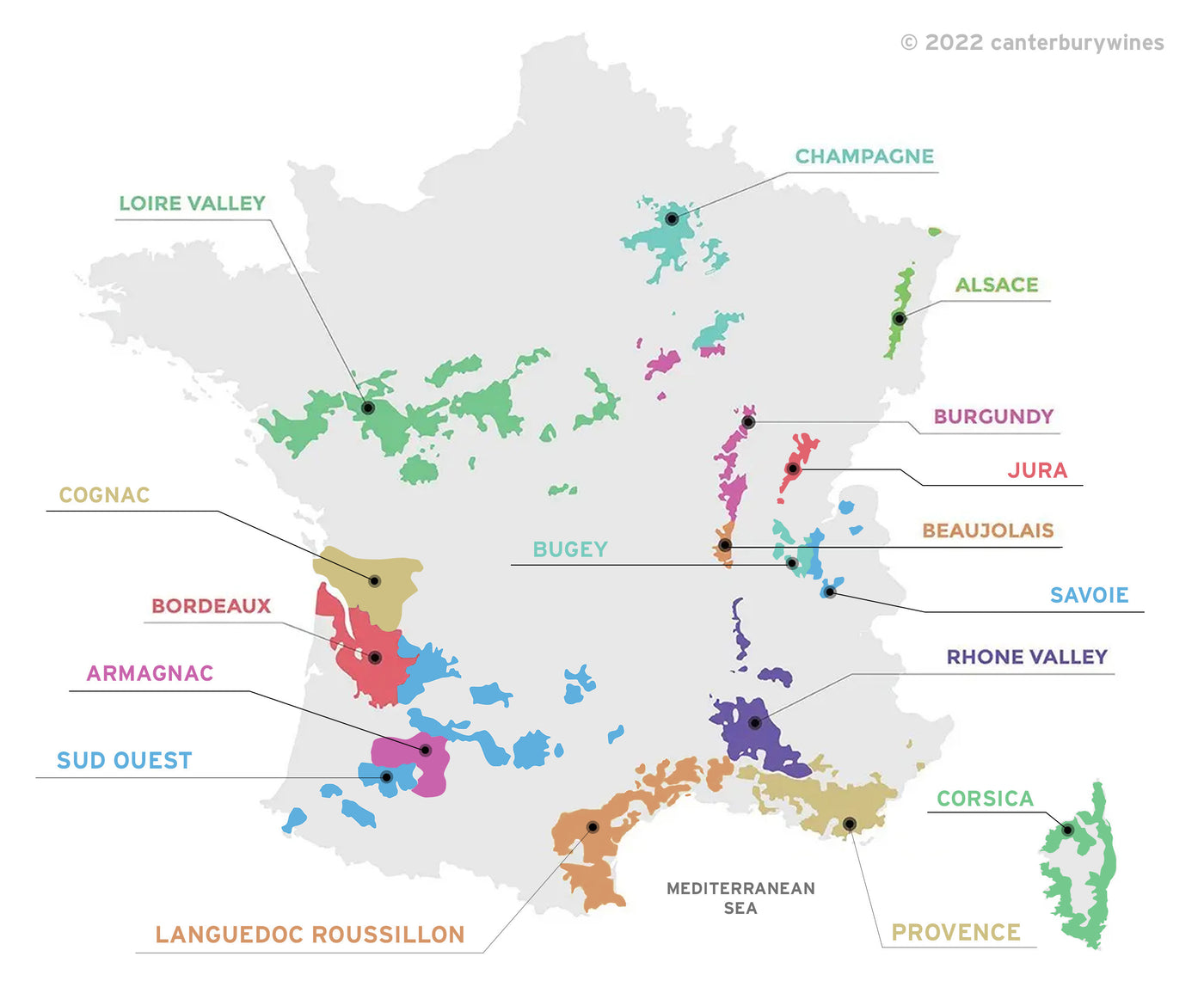
France
There are 16 major French wine regions, each known for their own unique grape varieties, terroir and wines. They are Alsace, Armagnac, Beaujolais, Bordeaux, Bugey, Burgundy, Champagne, Cognac, Corsica, Jura, Languedoc- Roussillon, Loire Valley, Provence, Savoie, South-West and the Rhône Valley.
The largest region is Languedoc- Roussillon, the oldest is Provence, the most influential and famous are Bordeaux, Burgundy, Champagne, Loire Valley and the Rhône Valley.
French wine is labelled by wine region or appellation rather than by grape variety (except in Alsace). In order to guarantee the quality and provenance of French wines, the French government established the Appellation d'origine contrôlée (AOC) system. Under this system the wine label indicates the geographical origin, quality and, generally, the style of a wine. Many regions are home to multiple appellations; for example, the prestigious Bordeaux region in the southwest of France has over 60 growing appellations.

